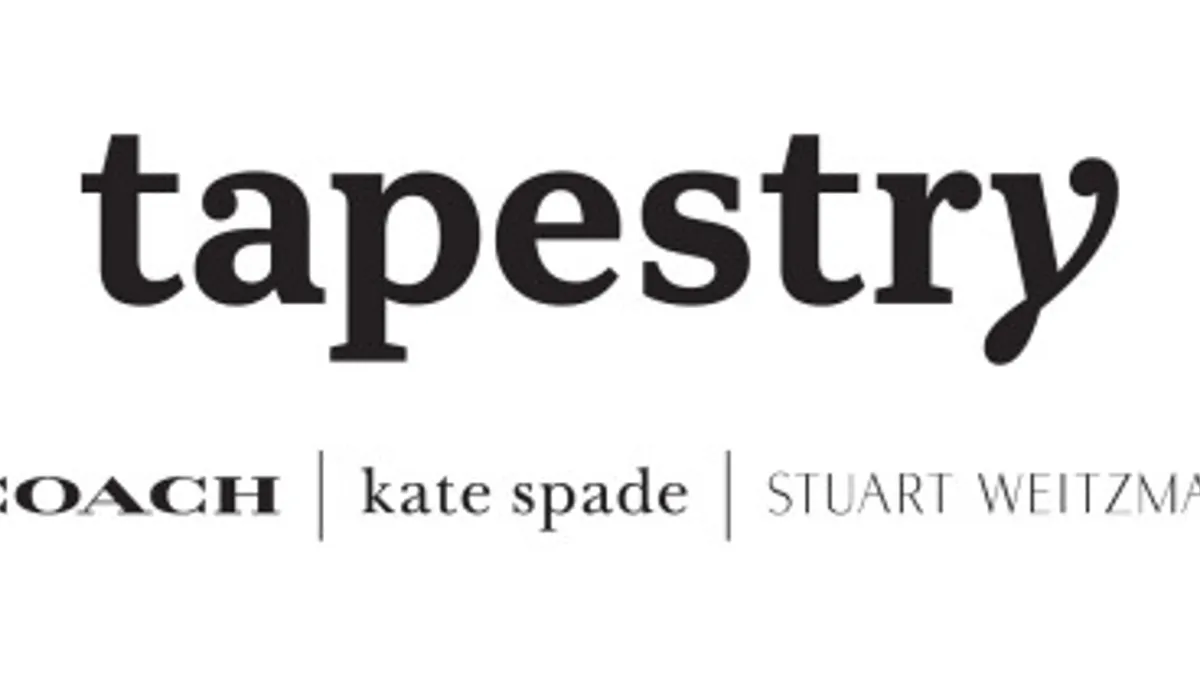Dive Brief:
-
Coach, Inc. on Thursday announced a major new branding strategy that, as of Oct. 31, includes changing its name to "Tapestry, Inc."
-
The name change reflects the fact that the company, after its recent acquisitions — of Stuart Weitzman in 2015 and Kate Spade & Company this summer — now has a stable of brands, beyond Coach, according to a company press release.
-
The company worked with branding agency Carbone Smolan Agency on all aspects of the rebrand.
Dive Insight:
Coach’s rebranding effort is akin to Google’s switch to "Alphabet," and the umbrella monikers of the likes of LVMH and Kering. In fact, it’s almost a shot across the bow, according to Manik Aryapadi, a principal in the consumer and retail practice of global strategy and management consulting firm A.T. Kearney.
"Beware, the Americans are coming!! Coach Inc.’s rebranding as 'Tapestry' is meant as a message to the market and to their consumers that they are serious about moving from a 'branded house' to a 'house of brands,'" Aryapadi told Retail Dive in an email. "It’s both a homage and a threat to the big three European fashion houses of LVMH, Kering and Richemont."
It could also be a sign that Tapestry aims to grow in the luxury space, he said. "Expect this move to be followed by more strategic acquisitions in the luxury sector that will allow Tapestry to grow their portfolio, and perhaps reignite their efforts to acquire Burberry," he said. "Michael Kors and Tapestry both have publicly announced their intention to challenge European dominance in the fashion luxury sector."
Although some press outlets documented street-level reactions to the change that drew negative connotations with the word "tapestry," the new name won’t likely affect customers' or loyalists' perception of Coach, according to Jim Fosina, CEO of Fosina Marketing Group. "The consumer facing brand name won't change and it is doubtful whether a branding change in the parent will really mean much to the Coach, Kate Spade, Stuart Weitzman customers," he said in an email to Retail Dive.
In fact, Coach CEO Victor Luis was brought in three years ago in part for his experience with not just luxury branding but also in such positioning, according to Jon Bierman, president and chief revenue officer of cloud-based product information management firm PlumSlice. Luis has helped shepherd the Coach brand back into the luxury space in his tenure.
"Among some very compelling internal competition, Victor Luis was chosen for the Coach CEO role in particular because of his prior background with luxury (LVMH and Baccarat) and the clarity of his vision for transforming Coach into a global holding company of affordable luxury," Bierman told Retail Dive in an email. "Since January of 2014, he has remained true to his transformative vision as demonstrated by some key decisions: the hiring of luxury designer Stuart Vevers to lead creative for the Coach brand, the enhancement of the overall brand image by reducing Coach's presence and discounting in department stores, and more recently with the acquisition of the brands Kate Spade and Stuart Weitzman."
Those brands have similar pricing structures and quality levels that enhance the overall company offering, Bierman said, and the company’s appointment earlier this year of former Bergdorf Goodman chief and head of Neiman Marcus’s NMG International unit Joshua Schulman to be Coach brand President and CEO frees up Luis to focus on the broader company and its growth strategies, Bierman noted.
"Brand consolidation has significant benefits, not the least of which are real estate negotiations, leveraging in-common corporate infrastructure and services, and streamlining of supply chains," he said. In fact, according to Bierman, a rebrand from "Coach" is more than a name change — it’s a required step in building a reputation for a powerhouse of brands.
In his statement, Luis said the company is in a "defining moment" in its corporate reinvention.
Achieving some of these goals will require work beyond branding, Fosina said. "It probably means that the holding company is going to consolidate their back end infrastructure and look for ways to consolidate elements of individual brand costs. A chance to look fresh at how the Tapestry holding company wants to operate its business units in order for each brand to be more efficient moving forward and more profitable," he said. "Tapestry must show how the seamless integration of these brands allows the company and its respective business units the ability to grab more of the overall consumer spending volume in their respective product categories."













